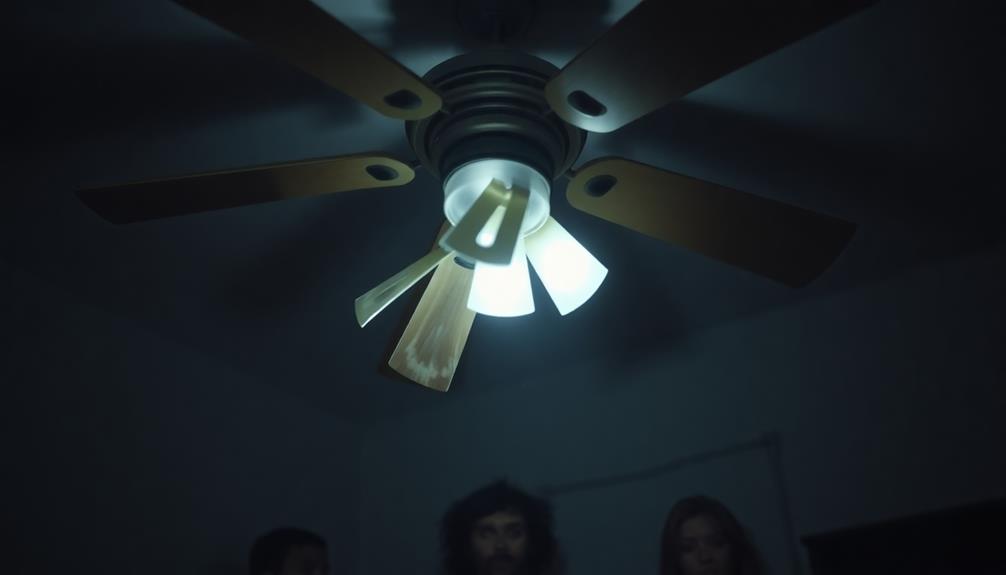Your ceiling fan can definitely be a falling hazard if it's not installed or maintained properly. Make certain you're following the manufacturer's installation guidelines and securing it to a sturdy ceiling joist. Regularly check for loose screws, unusual noises, or wobbling, as these can indicate instability. Confirm your fan is appropriate for the room size, and inspect it for wear at least twice a year. If you're unsure about its condition or installation, consider hiring a professional. Knowing how to spot potential issues can help you keep your fan safe and functional. Curious about more tips?
Key Takeaways
- Securely install the ceiling fan by following manufacturer guidelines to prevent it from becoming a falling hazard.
- Regularly inspect and maintain the fan for wear signs, such as wobbling or unusual noises that may indicate instability.
- Ensure the fan is mounted on a sturdy ceiling joist to provide adequate support and reduce the risk of falling.
- Use appropriate screws or bolts and consider a ceiling fan mounting kit for added stability during installation.
- Hire a professional for installation and maintenance if unsure, ensuring compliance with safety standards and local codes.
Installation Guidelines
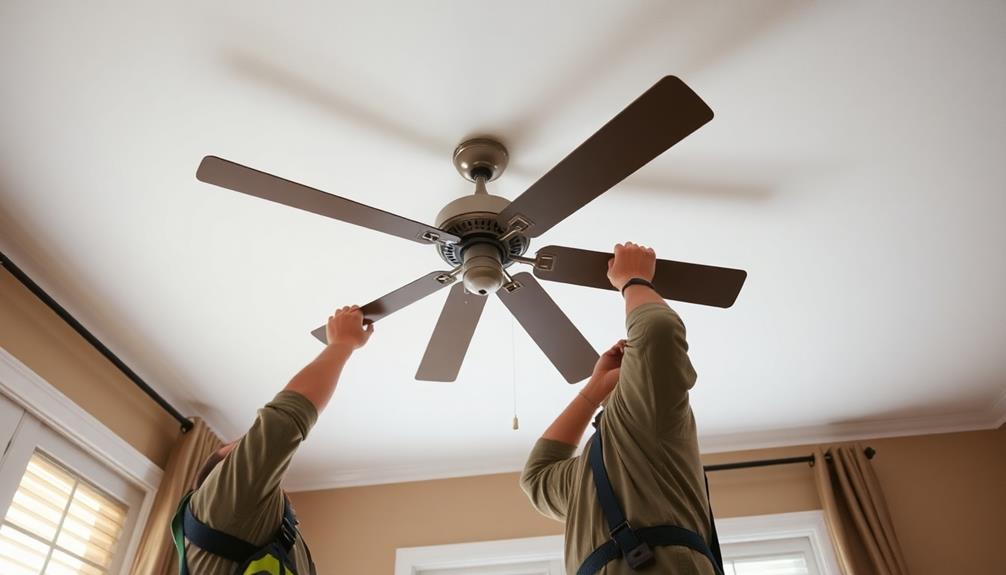
When installing a ceiling fan, it's vital to follow the manufacturer's instructions closely to guarantee safety and functionality. Additionally, ensure the mounting bracket is securely attached to a ceiling joist to support the weight of the fan. Proper wiring and balance are essential to avoid wobbling or operational issues. For optimal performance, refer to the ceiling fan rpm insights provided in the manual to select the appropriate speed settings for your space.
Start by selecting a sturdy ceiling joist, as this will provide the necessary support for your fan. Secure the mounting brackets tightly to the joist using appropriate screws or bolts to ensure stability. Consider using a ceiling fan mounting kit for added support.
Before connecting the electrical wiring, double-check all connections to make certain they're correct and secure. High-quality fans are designed to minimize wobbling, so choose one that's built for durability.
If you're unsure about any step, don't hesitate to hire a professional for installation. Proper installation is critical to avoid potential hazards down the line.
Maintenance Practices
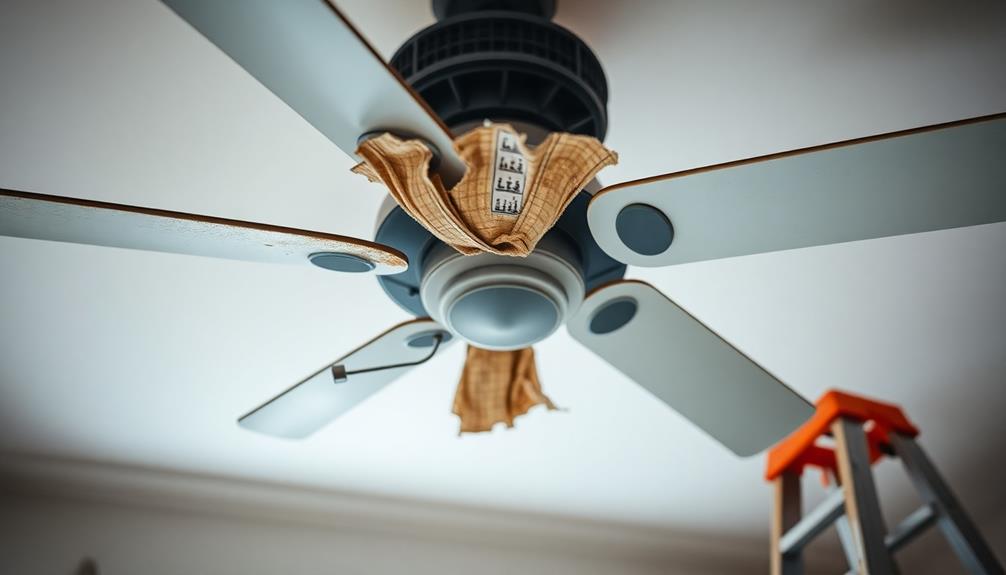
Proper installation sets the stage for effective maintenance practices that keep your ceiling fan running safely and efficiently.
To prevent potential hazards, regularly check and clean the fan blades and motor to eliminate dust buildup, as this can enhance airflow and improve overall efficiency, leading to lower energy bills.
You should tighten screws and connections every few months to guarantee everything remains secure. Look out for any signs of instability, like unusual noises or wobbling, and address these issues promptly.
Aim to inspect your fan at least twice a year for any damage or wear.
Remember, lubricating moving parts and balancing the blades are vital tasks that enhance performance and longevity.
Factors Affecting Stability
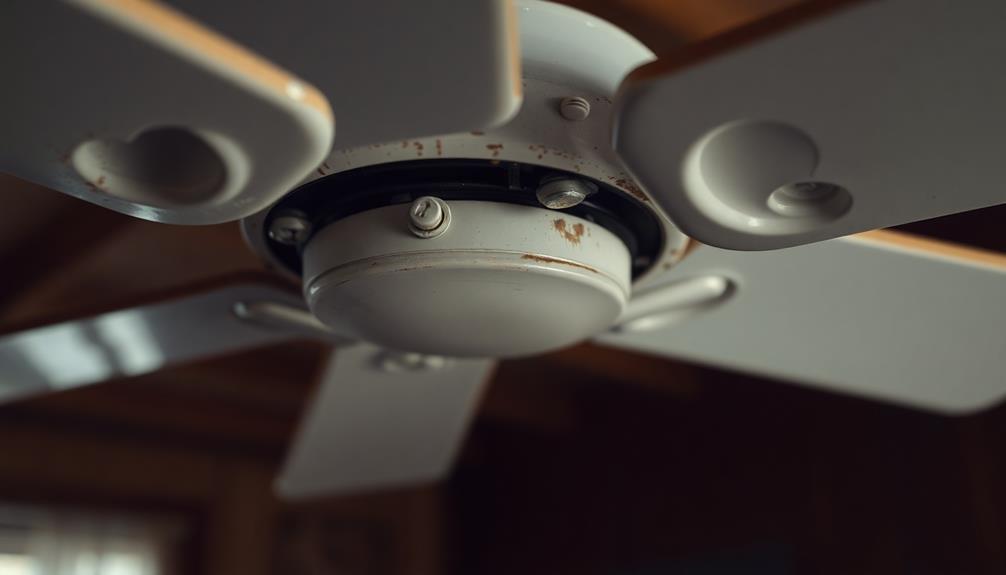
Several factors influence the stability of your ceiling fan, directly impacting its safety and performance.
Understanding these elements can help you maintain a secure installation and prevent accidents.
Here are some key considerations:
- Installation quality: Verify your fan is correctly mounted to a sturdy ceiling joist.
- Age and wear: Regularly inspect your fan for signs of deterioration that could compromise stability.
- Vibration issues: Worn components can lead to excessive movement and instability during operation.
- Environmental conditions: High temperatures and humidity can stress motors and affect overall fan performance.
Identifying Failures
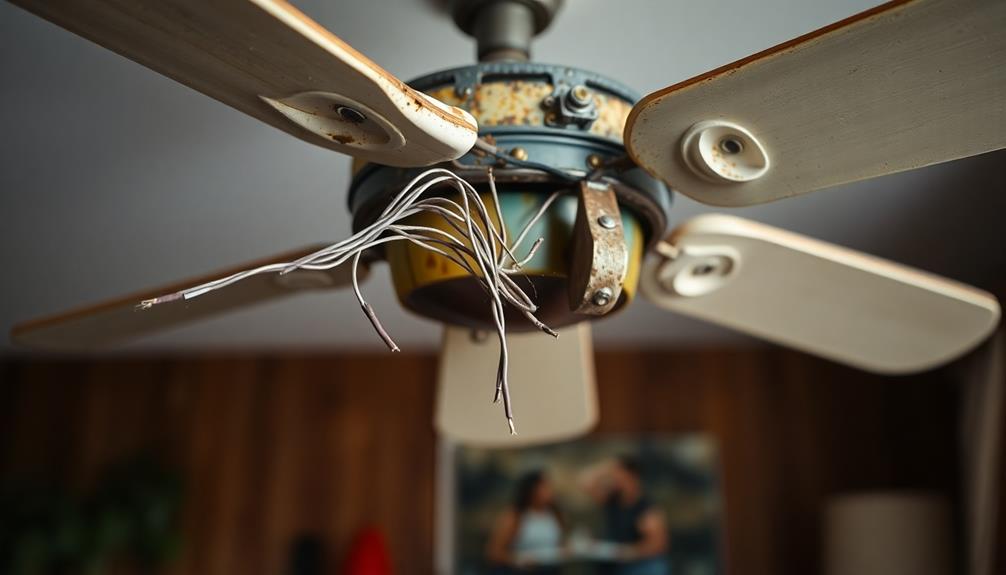
Identifying potential failures in your ceiling fan is essential for ensuring safety and preventing accidents. Common issues arise from improper installation or worn-out motor components.
If you notice unusual noises, it could signal loose parts or misalignment. Wobbling during operation is another red flag indicating potential instability. It's vital to address these issues early to mitigate risks.
Overloading the fan or exceeding weight limits can stress the unit, leading to malfunction. Also, keep an eye on fan speed settings; high speeds can increase instability.
Regularly monitoring your ceiling fan for these warning signs will help you maintain its functionality and safety, ensuring it remains a reliable fixture in your home.
Safety Precautions
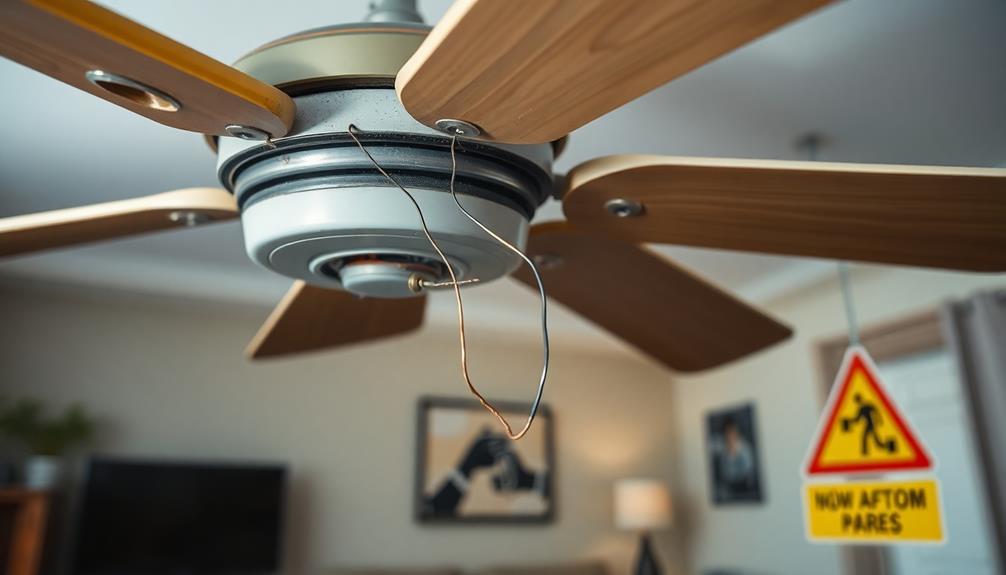
Taking safety precautions with your ceiling fan is essential for preventing accidents and ensuring smooth operation. By implementing a few simple measures, you can enhance safety and prolong the fan's lifespan.
Here are some important precautions to contemplate:
- Follow manufacturer guidelines for installation and maintenance.
- Regularly inspect the fan for signs of wear, such as wobbling or unusual noises.
- Ensure proper clearance around the fan, especially in low-ceiling areas.
- Use fans appropriate for your room size to prevent instability.
User Awareness
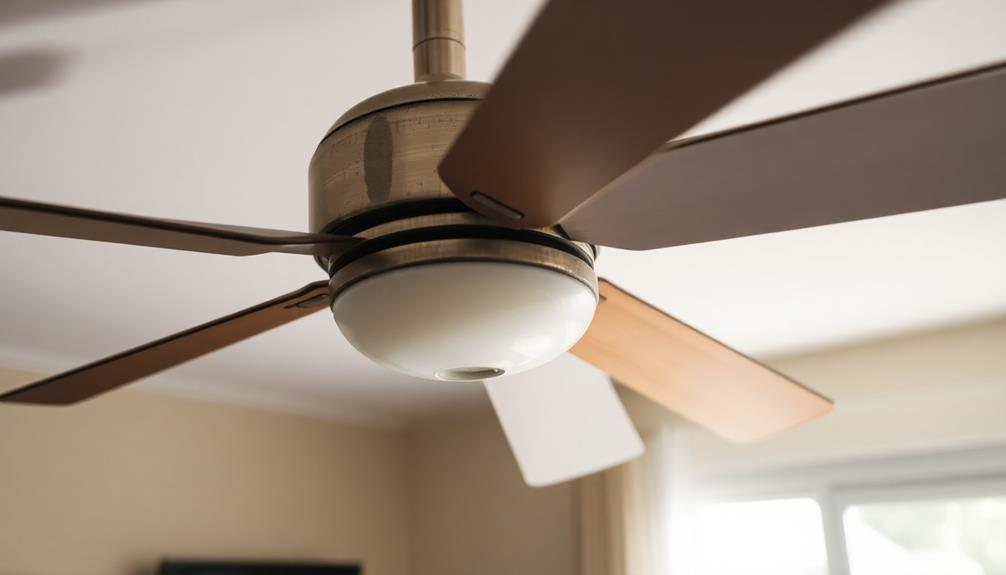
User awareness plays an essential role in maintaining ceiling fan safety and performance. You should familiarize yourself with safe operation practices, including following the manufacturer's guidelines for installation and usage.
Always verify your ceiling fan's size is appropriate for the room to prevent instability. Regularly inspect the fan for signs of wear, such as unusual noises or wobbling, which could indicate loose components.
Be mindful of environmental factors like humidity, as they can impact the fan's performance. Additionally, understanding the potential hazards associated with ceiling fans, such as overloading or exceeding weight limits, is vital.
Professional Assistance
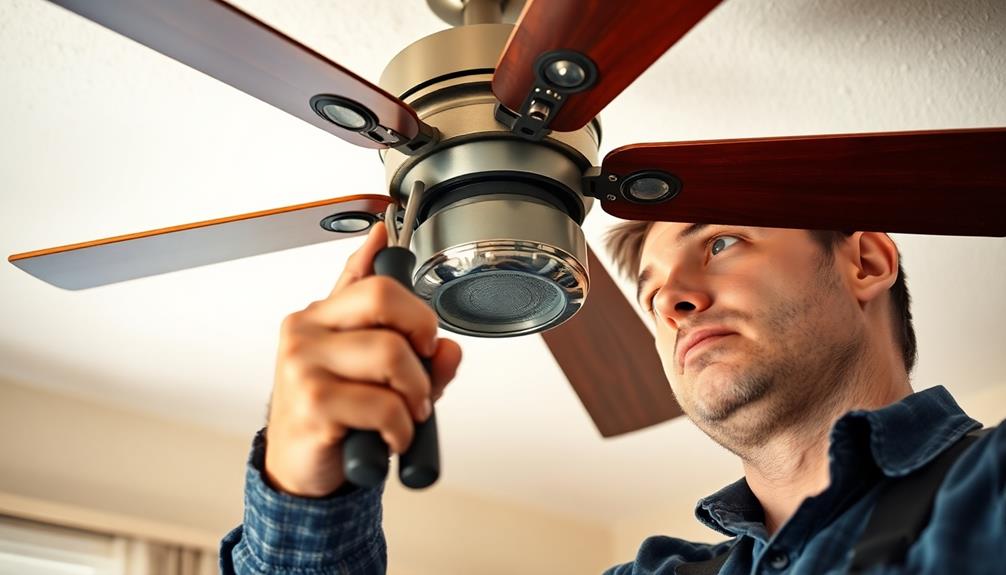
Hiring a professional for ceiling fan installation and maintenance can greatly enhance safety and performance. Their expertise guarantees that your fan is installed correctly and operates smoothly, reducing the risk of accidents.
Here are some key benefits of seeking professional help:
- Correct Installation: They follow manufacturer guidelines to guarantee your fan is securely mounted.
- Safety Compliance: Professionals adhere to local codes and safety standards.
- Regular Maintenance: They can perform routine checks to prevent wear and tear.
- Identifying Issues: Experts can spot potential problems early, such as wobbling or unusual noises.
Investing in professional assistance protects your home and enhances your ceiling fan's lifespan.
Don't compromise on safety—let the experts handle it!
Frequently Asked Questions
How Can I Tell if My Ceiling Fan Is Too Heavy for My Ceiling?
To determine if your ceiling fan's too heavy, check the manufacturer's weight recommendations, inspect your ceiling's joist strength, and guarantee secure mounting. If it wobbles or makes unusual noises, consider a lighter model.
What Types of Ceiling Fans Are Safest for Homes With Children?
Isn't safety your top priority? Choose ceiling fans with enclosed blades, lightweight materials, and secure mounting. Confirm they're installed correctly and regularly maintained, keeping your children safe while enjoying a cool breeze together.
Can Ceiling Fans Fall Due to Extreme Weather Conditions?
Yes, ceiling fans can fall during extreme weather, like high winds or heavy storms. To prevent this, guarantee your fan's securely installed and regularly maintained, paying attention to any signs of wear or instability.
What Should I Do if My Fan Falls?
If your fan falls, you'll want to act quickly—over 40% of household injuries come from falling objects. Check for injuries, turn off power, and consult a professional for repairs or replacement immediately. Safety first!
Are There Ceiling Fan Models Specifically Designed for High Ceilings?
Yes, there are ceiling fan models designed specifically for high ceilings. These models often feature longer downrods, ensuring ideal airflow. When selecting, consider the room size and fan specifications for the best performance.
Conclusion
In conclusion, staying savvy about your ceiling fan's safety is essential. By diligently dedicating time to proper installation, regular maintenance, and vigilant inspections, you can dodge dangerous dilemmas. Keep an eye out for signs of instability and don't hesitate to seek professional help when needed. With a little care and caution, you'll guarantee your fan continues to spin smoothly, providing a rejuvenating breeze without the worry of a falling hazard. Stay safe and enjoy your comfort!
